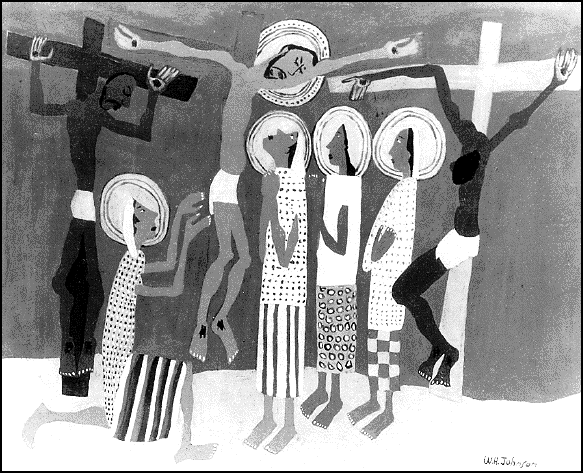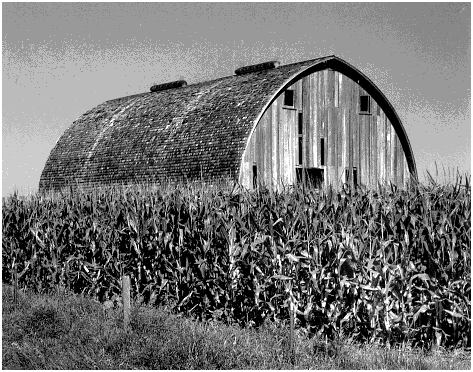
The Crucifixion in
American Art
Robert Henkes
(McFarland)The earliest paintings are from the mid 1700s, and include paintings of John Valentine Haidt, Benjamin West, and John Trumball. The three shown are obviously in the European Renaissance mold.The only famous artist represented in the 19th Century is John Singer Sargent, whose Tyrolese Crucifix is in watercolor, and not bad. The oddest from these early years are those of Fred Holland: platinum photograph prints in which he has mounted himself on the cross complete with long hair, nails (none, presumably, penetrating the flesh), and a saintly, nicely gowned Mary along with selected disciples at the base.
But the main delights in this book come from the first fifty years of the twentieth century. The primitive paintings from William H. Johnson are lively and painful and, can we use the phrase? --- filled with jazz. Later works, including Jonah Kiningstein offers a slashing death's head, and John Talleur's Burial are the stuff of nightmares.
There are a hundred or so photographs here, with short commentary on all the artists. The pity is that all the shots are black-and-white, so that we miss some of the true power of what they are representing.

Harker's Barns
<Visions of an
American Icon
Michael P. Harker
Jim Heynen, Text
(Iowa)What is it about these great behemoths that make them so attractive? Some are falling over, others are elaborate, with cupolas and windows, others half wood half siding, silos at one end (in one case, fallen over), stone, cross-hatch doors, overhangs, windmills. "Barns are the capitol buildings of a farm. The cupolas are capitol domes," says Heynen.The text may be redundant: what difference does it make? The seventy black-and-white photographs --- all from Iowa, such exotic towns as Tipton, Solon, Marengo, Bennett, West Amana, and a lovely fall-down, paint-flaked, roof-caved in number from Newhall --- lend themselves to being slashed out of the book and hung in your bedroom, study, or kitchen.

FOUNDation
<Transforming Found Objects
Into Digital Assemblage
Spencer Drate
(Watson-Guptill)Frida Kahlo's corset, a dirt cast sculpture hand, a Polaroid calendar, chopstick bags, pandas chewing on dollars ("Hello lazy panda ... we are here with the sack of live monkeys ... you requested ... they are very dirty sir ... just how you like them!"), poster for the RockCandy music club ("Engine kid sextet and deflowers at rockcandy march 10") and my most personal favorite, Bicycle lamp (p 70) by David Heasty.This is a collection of the wonderful and the strange, photo collages, announcements, birdhouses, print ads, typo kits, invitations, brochures, postcards, disc covers, postcard art, book covers (one of Seek My Face by John Updike is an eyecatcher --- which is, after all, the point, no?) It's all quite jarring, too. Especially the PeePod font [see below] which was inspired by those plastic filters that you find in men's urinals, right underneath the candy ("Photos were taken after extensive beer-drinking and peeing.")

What Was True
<The Photographs and
Notebooks of William Gedney
Margaret Sartor,
Geoff Dyer, Editors
(Lyndhurst/Norton)"They seem to be doing happy things sadly, or maybe they're doing sad things happily." The line is from John Cage, and William Gedney included it in a show of his photographs of the hippy world of San Francisco 1966 - 1967. And the black-and-white photographs show little of the supposed ecstasy of those years, but are, rather, zonked out young men and women, all looking this way or that, but not at each other, and certainly not very happy. This zonked out scene that we now tend to idolize is not the only part of this compelling book.
Shots from Kentucky, South Dakota, Brooklyn, Benares, Calcutta show people smoking, sitting in their cars, standing in doorways, playing cards, looking here and there: looking in store windows, looking at hands, looking at the camera, looking past each other --- and, so often, none of these people are connected. It's all very disturbing: it smells of sadness, loneliness, poverty, angst, isolation, meaninglessness. The Gedney archive now rests at Duke University, and the hundred or so images nicely reproduced here speak of a man who knew his craft well enough to show exactly what he wanted: that the world was a minefield of isolation, incomplete contacts and waiting, waiting, waiting.
We can love Gedney for his photographs, and can only wonder at the fact that he is so gracefully blind to the singularity of his craft when he writes, "I have spoken of India as a bittersweet land. It grows increasingly bitter. I have never let the bitterness show in my work."
Between Street
And Mirror
<The Drawings of
James Ensor
Catherine de Zegher
(The Drawing Center/
University of Minnesota)Journalist J.P. Hodin visited the Belgian artist James Ensor in 1948, and wrote the following:
Later, when I returned to Ensor's house, I found him sitting near the window, only half turned toward the door. He was wearing a soft black felt hat. His beautiful face with its regular features was rosy, and his bright forget-me- not- blue eyes were gazing across the room with a kindly expression. Not at me, yet slightly passive, tranquil, waiting. I stated the reason for my visit, raising my voice, for the expression of his face told me that he was hard of hearing. Behind the comfortable armchair stood Auguste [Boogaerts] with his little black cap and his Mephisto-like gaze. His face beamed with inward certainty, the reflected glory of his master's greatness, a self-confident limitation in contrast to Ensor's understanding gentleness.
Ensor pursed his lips before he articulated his words, as though tasting them first. We were strangers to each other. I knew that I would have to break the ice of this kindly detachment with my questions, or learn nothing.
On the walls hung countless small pictures of Ensor's. The room was filled with dark furniture; everywhere there was porcelain, big seashells and framed photographs. It was like being on a stage, translated into an Ibsen milieu.
On the table at Ensor's side stood his three last paintings. Auguste pointed at them emphatically. On one of the walls hung a portrait in dark tones reminiscent of Courbet, a work of Ensor's early period. On another wall was a larger painting in pastel colors --- pink and pale --- a stage decoration for Ensor's ballet "Love's Compass: The Flirting Marionettes."
In order to start the conversation, I said that I could well understand how difficult it was for the experts to classify his art. It was surreal because it was super-real long before the surrealists, and, at the same time, traditionally felt. It was symbolic in the conception of its motifs and impressionistic in the handling of the paint. It was expressionistic as a spontaneous representation of human emotions.
"I do not impose impressions," Ensor said in a soft, melodious voice. The smile on his face was warm and kind. "I attach no importance to labels. I don't like adjectives."
I mentioned that to me his art was so full of meaning and how unfortunate I thought the development of analytic-
constructive painting, which, because of its lack of meaning, has --- as André Gide so well said in his thoughts on Poussin --- become the symbol of our time. "Yes," Ensor nodded, "My art tends toward the literary. My pictures tend toward the outskirts of painting: But why generalize? It is possible to realize one thing or another, according to the impressions gained from one point of view or another. But it is too difficult to make a general rule."
I suddenly changed the subject, to surprise him out of his reserve. I referred to the restlessness of the time, the deep pessimism and nihilism that prevails everywhere, and I went on: "There are still people to be found who talk of progress, without recognizing that mechanized civilization has robbed us of our innermost strength and enslaved us."
"I see no evolution," Ensor said, pursing his lips. "I see nothing but a great uncertainty. And inquietude above all."
"Where will it all end?" I asked.
He shook his head. "I don't know. That probably lies outside our present power of comprehension."
He looked out of the window and I scrutinized him closely. How beautiful old men are, I thought, when their minds remain alive and harmonious, while old age exacts its due. I felt a burning desire to ask him about ultimate spiritual things. I risked it.
"Do you believe in life after death?"
"No," he said decidedly. Auguste smiled.
"And the meaning of death? Is it sufficient to regard it as something 'natural?"'
"It's very difficult...."
"Have you been tormented by the enigma of life?"
"Certainly. I have searched, yes, but not found; but perhaps this is an answer to your question: I am content --- I let myself be cradled by events. I have faith in major forces."
That's it, I said to myself; one gives way. Death is stronger. Perhaps this is wisdom, perhaps it is mere resignation?
When I told Ensor about my doubts, he gave me a lively glance and said, "You accord the individual too much importance. He has no particular significance."
Auguste had been listening impatiently for a long time and now he burst out, "The Master is not a philosopher! After all, he's a painter."
I would not let myself be put off. A quick answer for Auguste, "But there is philosophy in his pictures, not only painting!" And so to the next question for Ensor: "God --- how do you conceive of God?"
"God is a force. He is that which is strong." And, after a pause, "God is what we believe in."
Auguste threw in categorically, "The Chinese, think of the Chinese. It's evident, there are very many gods."
I nodded to him soothingly and said quickly to Ensor, for I felt that I was tiring him, "But why did you paint Christ in your painting of the entry into Brussels? And why Brussels?"
"I chose Brussels, but it might as well have been another place. And Christ..." Ensor said, pausing --- Auguste broke in: "The Master is a bad catholic but a great revolutionary."
"You should write a book about it," I retorted.
"I am waiting until others have made the mistakes."
It was impossible to get the better of that fellow!
"Christ," Ensor repeated, "is a very great figure. People have thought a great deal about this figure. The Christ is an inescapable symbol."
After these words, Ensor gazed into space for a long time without speaking. He looked at a small picture on the wall, two female figures, one in a red dress, the other in blue. "At first they were naked," he said, "but they were far from beautiful."
§ § § This gorgeous volume runs some 250 pages. It contains a few photographs of the artist, along with 150 or so of his sketches and drawings. The pictures are weird, strange, wonderful, horrible, odd, filled with Christs, goblins, ghosts --- and old women immersed in scary dreams [see below]. Ensor himself looks to be a sweet, unassuming man, but his self-portraits can be a little off-putting, too --- especially the ones showing his head turning into a skull.
--- R. E. Fretwell, III